A Presidency made in Lancashire
and live on Freeview channel 276
resident Joe Biden has just sworn his presidential oath on a Haydock bible which was originally published by a Lancashire man in the 1800s.
Thomas Haydock was a publisher based in Cottam, Preston, and his brother George Leo Haydock provided the commentary for the bible when it was published in 1814. Biden, who is Catholic, has used the leather-bound, five inch thick book each time he’s been sworn into elected office during the course of his career.
Advertisement
Hide AdAdvertisement
Hide AdIn 1961, the 150th anniversary of Haydock’s first edition, the first Catholic President of the United States, John F Kennedy (1917–1963) would take his inaugural oath of office on a copy of a Haydock Bible owned by his mother’s family, the Fitzgeralds.
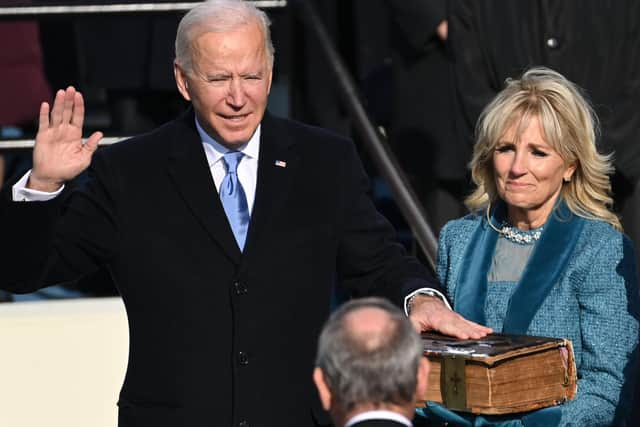

Being sworn in on a Bible is not required by the US Constitution, but modern-day presidents have adhered to tradition and chosen symbolic bibles for their inauguration days.
The tradition itself dates back to President George Washington, who was sworn in using a Masonic Bible in 1789.
The Haydock bible is not the only presidential link to Lancashire; by ancestry President George Washington was a Lancashire man, with family connections going back several centuries to Warton-in-Lonsdale (now Warton).
Advertisement
Hide AdAdvertisement
Hide AdIt was only four years ago that the parishioners of St Mary’s in Newsham near Preston discovered their link with the Haydock family.
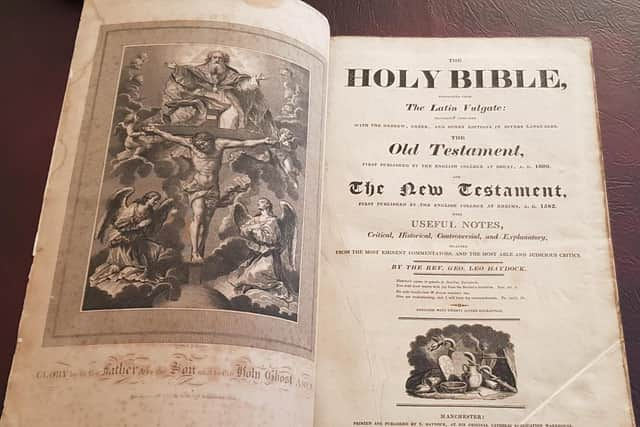

John Bleasdale, a member of the parish of St Mary’s Newsham, said: “We were contacted by an American called Sydney Ohlhausen who is from Houston, Texas.
“He is a man who is very interested in bibles, he has a collection of antique English bibles and testaments, over 1,900 editions in fact, he is well known in the world of bible collectors. He contacted us about the Haydock family grave which is in our graveyard at the church.
“The existing church was built in 1906 but there have been earlier Catholic churches here.
Advertisement
Hide AdAdvertisement
Hide Ad“He felt a memorial ought to be put up in memory of Thomas Haydock. Sydney commissioned an architect Edward Holden RIBA based in Devon.
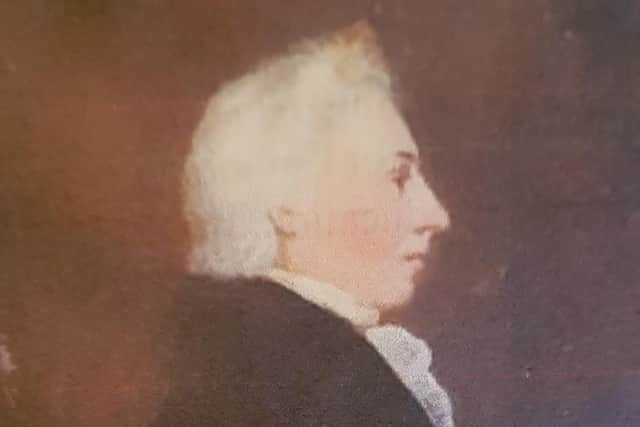

“The stone was obtained and mined in China and was prepared by a stonemason from one piece of granite which includes the bible on top. The bible is the actual size of the real bible.
“That was then erected in 2016 and then on Sunday, May 15, 2016, Bishop Campbell of Lancaster blessed the memorial.
“Thomas Haydock was born in Cottam in 1772 (died in 1859), he himself went to a seminary with a view to becoming a priest but was not actually ordained.
Advertisement
Hide AdAdvertisement
Hide AdHis brother George Leo Haydock was born in 1774 (died 1849).
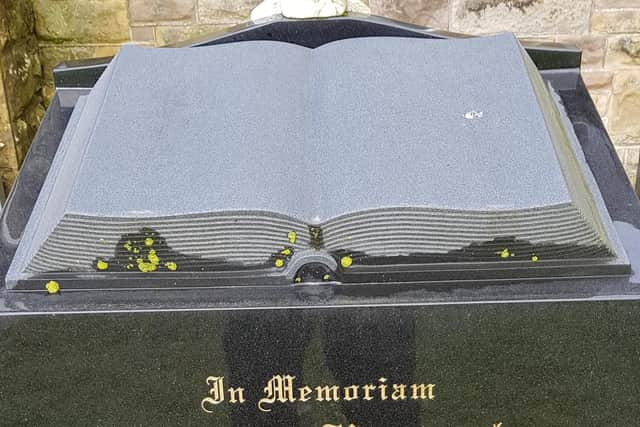

“Thomas Haydock was into publishing and he had these bibles printed in folio (a sheet of paper folded once to form two leaves - four pages - of a book).
“He did it in various sections and they were sold as parts and then the parts could be bound into a volume.
“It was such a huge book and a great deal of commentary in the book was done by his brother George.
Advertisement
Hide AdAdvertisement
Hide Ad“People would buy the sections to make into a huge book, people could pay in instalments and that’s how they could afford it.
“George Leo Haydock was a priest, pastor and bible scholar.
“He served in Whitby for a while but then was not allowed to practice over a debt of money,
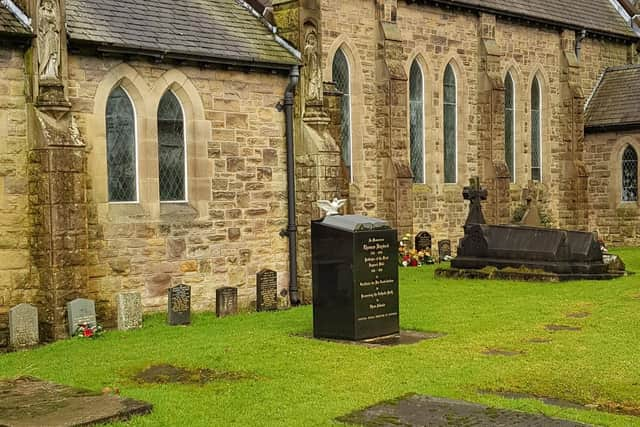

“He subsequently went to Penrith. His commentary is in the bible and that is why the Americans are keen on this. John F Kennedy was the first Catholic President and he used a copy of this bible when he took the presidential oath on January 20, 1961. It was his mother’s family bible.
Advertisement
Hide AdAdvertisement
Hide Ad“When President Joe Biden was vice president and president he swore his oath on a Haydock bible.
“It is his family’s bible and it has been 163 years in his family.
“The Irish people would buy the bible and when the Irish dispersed to America they took it with them.
“An edition of the Haydock bible was published in the USA as a folio edition by Eugene Cummiskey in Philadelphia that remains to this day the only folio Catholic Bible ever published in America.
Advertisement
Hide AdAdvertisement
Hide Ad“At the church in Newsham, the Haydock family grave is next to the memorial commissioned by Sydney Ohlhausen. Thomas Haydock is buried there.
“The Haydocks were just a good Lancashire family. If Sydney Ohlhausen hadn’t highlighted the Haydock family, none of this would have happened.
“He was the one who alerted us to its importance. We’ve got one of the bibles which is on display in the church from time to time.
“The bible is his enduring legacy and he never imagined the long term success of his bible which would remain in print until 1910.”
Advertisement
Hide AdAdvertisement
Hide AdThomas Haydock, born of one of the oldest English Catholic Recusant families, was a schoolmaster and publisher.
He is best remembered for publishing an edition of the Douay Bible with extended commentary, compiled chiefly by his brother George Leo Haydock.
Originally published in 1811 and still in print, it is one of the most enduring contributions to Catholic biblical studies.
Haydock was born on February 21, 1772 in Cottam, Preston.
Although most prominent British families embraced the new Protestant religion, many Haydock descendants would rank among the most vocal and influential of those who remained faithful to Catholicism.
Advertisement
Hide AdAdvertisement
Hide AdThe Lancashire area especially was slow to relinquish its faith.
In later centuries Lancashire would retain a small but determined Catholic population supported by families of the landed gentry, sometimes hosting secret Masses in their homes.
The Haydocks were among the most prominent of these families and became legendary in their service to the Catholic Recusant movement.
Thomas Haydock was part of a unique generation whose combined contributions to this family tradition would be extraordinary.
Advertisement
Hide AdAdvertisement
Hide AdAfter receiving his elementary education at a school established for Catholic students at Mowbreck Hall, in Wesham,Thomas was sent in 1785 to the English College, in Douai, France, where he joined his brother, George.
Both Haydock brothers managed to elude the authorities and escape back to England.
Continuing his pursuit of ordination, Thomas next went to the English College, Lisbon.
His superiors there did not feel he had a priestly vocation and sent him home in 1795. Undeterred, he went to the new seminary established at Crook Hall, Durham, with George in 1796. Again, his vocation was questioned.
Advertisement
Hide AdAdvertisement
Hide AdHowever, against the wishes of his older and recently ordained brother James, he was finally persuaded to leave the seminary.
Family friend and former Douay professor Benedict Rayment (1764–1842), who would later serve as editor of some of Haydock’s published works, remarked that of the three Haydock brothers seeking the priesthood, ‘’Thomas would have been the best’’.
Haydock moved to Manchester to begin his secular career. He opened a language school which proved successful. However, his love of literature drew him to publishing.
Encouraged by his elder brother James, he began his publishing career in 1799 with a new edition of The Garden of the Soul, a popular prayer book by Richard Challoner (1691–1781), and Letter on Papal Supremacy to the Rev. Geo. Bruning.
Haydock’s works were mostly devotional.
Advertisement
Hide AdAdvertisement
Hide AdThe Doway or Douay Bible (Douay-Rheims Bible) was the standard translation for English speaking Catholics.
A large new edition of the bible complete with an extended commentary seems a daunting project for a publisher of Haydock’s limited means.
Haydock’s old friend Father Benedict Rayment at first offered to compile the commentary for the new bible, but soon withdrew.
Haydock then enlisted George, by now ordained and a pastor of the mission at Ugthorpe, for the project.
Advertisement
Hide AdAdvertisement
Hide AdProduction of the bible would be delayed well beyond the original 1807 projected date.
Thomas went to Dublin to settle some business affairs and to open a new establishment.
He did not return to Manchester until 1810. In a peculiar turn of events, a competing Catholic Manchester publisher, Oswald Syers, had begun publishing his own Douay Bible in March 1811.
Embarrassed by his delay, Haydock had to move quickly to begin his own edition four months later.
Advertisement
Hide AdAdvertisement
Hide AdSyers finished his edition first, by 1813. However, Haydock’s more impressive edition, completed in 1814, quickly overtook it in popularity.
As were many editions of the bible at the time, Haydock’s was published and sold by subscription, a few leaves at a time, in fortnightly ‘numbers’.
Subscribers would accumulate the numbers and ultimately have the completed Bible bound.
As the bible progressed, new general title pages were issued in 1811, 1812,1813, and 1823, showing variously Thomas Haydock’s Manchester or Dublin locations.
Advertisement
Hide AdAdvertisement
Hide AdMost copies of the complete bible would include leaves published from both locations. Given Haydock’s limited resources, his bible must be considered a remarkable achievement.
The bible received an enthusiastic welcome from English and Irish Catholics.
At least 1,500 copies of the first edition were sold.
Haydock’s folio bible would continue in circulation until at least 1823, with a separate New Testament appearing in 1831.
Circa 1818 Haydock married Mary Lynch or Lynde of Dublin. Unfortunately, tragedy would dog his family life, just as it did his business and Mary died in 1823.
Advertisement
Hide AdAdvertisement
Hide AdTheir three children all died young. The name of only one is known: George (1822–1840).
Haydock struggled on with publishing at least until 1831, when he was able to reissue the New Testament portion of his original folio bible.
No dated works after that year are known, although he published undated works that may have appeared later.
In 1832 he made an unsuccessful attempt to begin a journal called The Catholic Penny Magazine.
Advertisement
Hide AdAdvertisement
Hide AdAt some point, he opened a school in Dublin where he resumed teaching until 1840.
He left Dublin probably about that year and moved first to Liverpool, then to Preston.
He could only watch as other publishers enjoyed success with new editions of his bible: two British editions, one in 1845-48, another ca. 1853, and an American edition in 1852-4.
He died at Preston in 1859, aged 87, with an estate valued at “less than 100 Pounds Sterling.”
Advertisement
Hide AdAdvertisement
Hide AdHe was buried in the Haydock family plot at St Mary’s Church, Newsham, near Preston.
After his death, new editions continued to appear on both sides of the Atlantic, keeping it in print until at least 1910.
Late in the 20th century, a new series of editions began to appear, prompted by the interest of traditionalist Catholics.
The Haydock Bible reached its bicentennial anniversary in 2011 not only still in print, but also quite at home in the digital age, appearing on CDs and online.
Comment Guidelines
National World encourages reader discussion on our stories. User feedback, insights and back-and-forth exchanges add a rich layer of context to reporting. Please review our Community Guidelines before commenting.